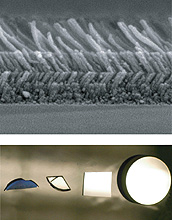News Release 07-020
New Coating Is Virtual Black Hole for Reflections
Non-reflecting material may help solar cells catch more of the Sun's rays

Layers of silica nanorods look like shag carpet when viewed with a scanning electron microscope.
March 1, 2007
This material is available primarily for archival purposes. Telephone numbers or other contact information may be out of date; please see current contact information at media contacts.
Researchers have created an anti-reflective coating that allows light to travel through it, but lets almost none bounce off its surface. At least 10 times more effective than the coating on sunglasses or computer monitors, the material, which is made of silica nanorods, may be used to channel light into solar cells or allow more photons to surge through the surface of a light-emitting diode (LED).
Publishing in the March 1, 2007, Nature Photonics, lead author Jong Kyu Kim and a team from Rensselaer Polytechnic Institute in Troy, N.Y., reveal how they crafted the coating, which reflects almost as little light as do molecules of air.
Guided by National Science Foundation-supported electrical engineer Fred Schubert, the researchers developed a process based on an already common method for depositing layers of silica, the building block of quartz, onto computer chips and other surfaces.
The method grows ranks of nanoscale rods that lie at the same angle. That degree of the angle is determined by temperature. Under a microscope, the films look like tiny slices of shag carpet.
By laying down multiple layers, each at a different angle, the researchers created thin films that are uniquely capable of controlling light. With the right layers in the right configuration, the researchers believe they can even create a film that will reflect no light at all.
One critical application for the material is in the development of next-generation solar cells. By preventing reflections, the coating would allow more light, and more wavelengths of light, to transmit through the protective finish on a solar cell surface and into the cell itself. Engineers may be able to use such a technique to boost the amount of energy a cell can collect, bypassing current efficiency limits.
Another application would involve coating LEDs to eliminate reflections that cut down the amount of light the LED can emit. The researchers hope the efficiency gains could allow the light sources to compete more effectively with fluorescent and incandescent bulbs. So, they will next focus their attention on solid state lighting.
-NSF-
Media Contacts
Joshua A. Chamot, NSF, (703) 292-7730, email: jchamot@nsf.gov
Jason Gorss, Rensselaer Polytechnic Institute, (518) 276-6098, email: gorssj@rpi.edu
Program Contacts
Rongqing Hui, NSF, (703) 292-8339, email: rhui@nsf.gov
Principal Investigators
Fred Schubert, Rensselaer Polytechnic Institute, (518) 276-8775, email: EFSchubert@rpi.edu
Related Websites
Fred Schubert's homepage: http://www.rpi.edu/~schubert/
Rensselaer Polytechnic Institute press release: http://news.rpi.edu:80/update.do?artcenterkey=1956
NSF award supporting this research: http://www.nsf.gov/awardsearch/showAward.do?AwardNumber=0401075
The U.S. National Science Foundation propels the nation forward by advancing fundamental research in all fields of science and engineering. NSF supports research and people by providing facilities, instruments and funding to support their ingenuity and sustain the U.S. as a global leader in research and innovation. With a fiscal year 2023 budget of $9.5 billion, NSF funds reach all 50 states through grants to nearly 2,000 colleges, universities and institutions. Each year, NSF receives more than 40,000 competitive proposals and makes about 11,000 new awards. Those awards include support for cooperative research with industry, Arctic and Antarctic research and operations, and U.S. participation in international scientific efforts.
Connect with us online
NSF website: nsf.gov
NSF News: nsf.gov/news
For News Media: nsf.gov/news/newsroom
Statistics: nsf.gov/statistics/
Awards database: nsf.gov/awardsearch/
Follow us on social
Twitter: twitter.com/NSF
Facebook: facebook.com/US.NSF
Instagram: instagram.com/nsfgov


